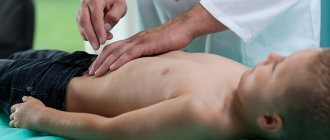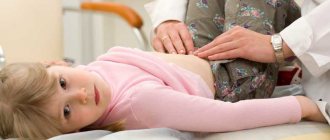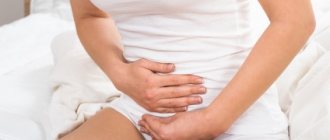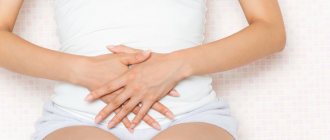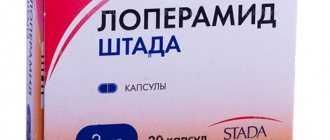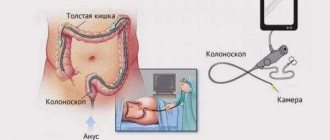Main causes of nausea and abdominal pain
We can say with confidence that such unpleasant symptoms as abdominal pain and nausea have been experienced by every person at least once in their life.
There are a huge number of reasons for this condition, but most often, when the stomach hurts and feels nauseous, this indicates food intoxication. In addition, the stomach almost always hurts and nausea occurs if there are problems with the gastrointestinal tract. Additional symptoms may include heartburn, rumbling in the stomach, and increased gas production.
Among the main reasons are the following diseases:
- gastritis;
- pancreatitis;
- pathologies of the biliary tract;
- kidney and liver diseases;
- oncological formations.
Important!
Severe abdominal pain accompanied by nausea occurs during an acute attack of appendicitis. In this case, it is very important not to confuse a dangerous pathology with an upset stomach or poisoning and provide timely assistance.
Abdominal pain accompanied by nausea and vomiting may also be associated with the following pathologies:
- With the development of myocardial infarction
. An additional symptom is that the pain radiates to the left shoulder, and this should be a serious reason for an urgent examination. - With food intolerance to certain foods
. In this case, the body refuses to digest certain foods normally. This is usually accompanied by increased gas formation, diarrhea and severe weakness. - Infected with intestinal parasites
. The reason for this is non-compliance with hygiene rules, as well as the consumption of low-quality water and products.
Not often, but still, abdominal pain and nausea may not be associated with pathology of the digestive system.
For example, symptoms may be caused by:
- Orthopedic deviations when there are problems with the spine.
- Stressful conditions that negatively affect the state of the digestive organ.
Women often have stomach pain and nausea during menstruation, as well as with various diseases of the reproductive system. During pregnancy, this condition indicates the development of toxicosis. In this case, it is imperative to inform the doctor about the manifestation of such symptoms.
The role of toxic substances
https://www.youtube.com/watch?v=https:TgLFkBfF-OY
Abdominal pain and dizziness are caused by:
- food poisoning from poor quality products;
- toxins and poisons ingested through food (mushrooms, botulinum toxins);
- viruses.
Clinical manifestations begin several hours after consuming a dangerous product. They are distinguished by multiple lesions of family members, holiday parties, and children's groups. An overdose of drugs can also be considered as an example of poisoning of the body.
Food poisoning
The product that caused the poisoning could be meat, milk, fish, cottage cheese, sausages, or “yesterday’s” salad. The cause of poisoning is usually associated with an attempt to use products purchased at a lower price than the usual price, products with an expired shelf life, or violation of the rules of culinary processing and storage.
The causative agents are pathogenic species of Escherichia coli, staphylococcus, and clostridia. Patients experience: vomiting of eaten food, pain in the epigastrium and around the navel, dizziness and headaches, diarrhea, “darkening” in the eyes, fever, chilliness of the hands and feet;
Dizziness and weakness from food poisoning last about two weeks after recovery Headache, dizziness, nausea and weakness
Gastric lavage, drinking plenty of fluids, and taking enterosorbents (activated carbon, Enterosgel) help remove pathological microorganisms and their breakdown products. It is not recommended to take anti-diarrhea medications. In severe cases of dehydration or severe intoxication, fluid is administered intravenously.
Botulism
The disease is considered toxic-infectious with primary damage to the nervous system. The pathogen (from the genus Clostridia) lives in the soil. 7 varieties have been studied. Spore formation is typical. A person becomes infected with soil-contaminated foods through unwashed hands and by eating undercooked meat from domestic animals.
Headache, nausea and stomach pain
Less commonly, a dust route of infection is possible. The toxin releases gas. We see it when the shape of bomb cans with canned food is disrupted.
Once in the stomach, it is not destroyed by hydrochloric acid. Quickly absorbed into the blood. It affects the nerve pathways transmitting motor impulses from the brain and spinal cord. In this case, the sensory fibers do not change.
The respiratory muscles of the chest are the most affected. Their inaction contributes to the inability to breathe independently against the background of full consciousness and dizziness. Therapy requires urgent administration of anti-botulinum serum (with repetitions per course), detoxification by gastric lavage and cleansing enemas, anti-inflammatory drugs, B vitamins.
The time until complete recovery depends on the severity of the disease, taking up to two months or more.
Viral diseases (ARVI, influenza) are often accompanied by abdominal pain and diarrhea mixed with blood. This is a variant of the course of viral and rotavirus infections. In recent years, increasing importance has been attached to viral hepatitis caused by herpes.
Signs of “stomach” flu include pain in the epigastric region that appears against the background of general intoxication, headaches, dizziness, and diarrhea. More often they are accompanied by vomiting.
Treatment requires drinking plenty of fluids, a gentle diet, taking Interferon and immunomodulators, vitamins, and bed rest for at least five days.
Drug poisoning is less noticeable, so we can call it the negative effect of drugs on the human body. When purchasing treatments at a pharmacy, you need to familiarize yourself with the side effects and contraindications.
As an example, we will give the possibility of poisoning with ascorbic acid, which many consider especially useful in the winter and spring. Ascorbic acid is one of the components of vitamin C. It is necessary for many biochemical processes. Since it is not synthesized on its own, it must be supplied with food.
But this does not mean that it should be taken completely uncontrolled. The instructions clearly state the doses for children and adults. Overdose occurs:
- when consumed simultaneously with vitamin-rich fruits;
- exceeding the dosage;
- weakening of the body’s defenses after infectious diseases;
- pregnancy.
Signs include severe dizziness, vomiting, and epigastric pain. It is important that no one thinks about overdosing and people continue to take even more. Poisoning goes away a few days after stopping the drug. Toxic symptoms of poisoning accompany women's use of contraceptives and taking medications for the purpose of suicide (barbiturates, painkillers, sedatives).
Associated symptoms indicating the disease
The development of a certain pathology can be roughly determined by the accompanying symptoms, but it should be understood that the final diagnosis can be made only after examination.
Stomach pain and vomiting
Abdominal pain, which is accompanied by vomiting, always indicates the development of an inflammatory or infectious process. Such symptoms indicate that the human body is trying to remove toxins, and the reasons for this can be very diverse.
Main reasons:
- Food poisoning
. An additional symptom may be increased body temperature. - Liver diseases
. In this case, the pain syndrome is localized in the area of the gallbladder (right hypochondrium). - Appendicitis
. It is very important to recognize this pathology in a timely manner, otherwise it poses a threat to life. The most common location of pain is the lower abdomen. - Strangulated hernia
. In this case, the pain covers the entire abdominal cavity, which makes diagnosis much more difficult. - Exacerbation of stomach ulcers
. This pathology may be accompanied by diarrhea or constipation.
Lower abdomen hurts
When the lower abdomen hurts, it is caused by various diseases of the abdominal cavity. Pain in this localization may occur due to the formation of kidney stones. This pain is very excruciating, it radiates to the back area. In severe cases, the pain syndrome is accompanied by chills and nausea, and blood often appears in the urine.
Other pathologies that cause pain in the lower abdomen:
- Irritable bowel syndrome
a. In this case, spasmodic pain occurs, increased gas formation is observed, as well as alternating constipation and diarrhea. - Appendicitis
. Such pain can be observed for a long time, but under certain circumstances an exacerbation may occur, which requires urgent medical intervention. - Ulcerative colitis
, which is associated with the appearance of ulcers on the walls of the colon and rectum. Along with severe pain, fatigue and weight loss are always observed, and bloody diarrhea appears over time. - Urinary tract infection
. Such diseases are very often observed in women. - Mesenteric adenitis
, which is characterized by inflammation of the glands on the walls of the small intestine as a result of viral infection.
My head is spinning
Cephalgia (headache) and dizziness with abdominal pain can develop due to the fact that acute pain syndrome provokes cerebral vascular spasm. As a result, hypoxia occurs. As a rule, dizziness begins suddenly, the reasons for this can be serious pathologies, such as: perforated ulcer, acute pancreatitis, renal colic, acute cholecystitis, cholelithiasis.
In addition, the stomach and head can hurt at the same time due to allergic manifestations of premenstrual syndrome in women, nervous strain and stress, or increased physical activity.
Diarrhea (diarrhea)
A combination of symptoms such as abdominal pain and diarrhea is most often a sign of poisoning.
In this case, it may be caused by:
- Chemicals that are part of various detergents, paints and solvents, and sometimes even medications.
- Viruses and bacteria, after infection with which manifestations of intoxication are observed.
- Poor quality food.
In addition, various inflammatory processes can cause diarrhea and abdominal pain. Against this background, serious diseases such as colitis, enteritis, and appendicitis develop.
Abdominal pain in the navel area
The most likely cause of pain in the navel area is an inflammatory process. In addition, pain can be localized in this place when pathologies occur in the kidneys, stomach or ureters.
Among the serious diseases that can cause pain near the navel are the following pathologies:
- Omphalitis.
- Neoplasms of a benign or malignant nature.
- Enterocolitis, which is characterized by spasmodic pain.
- Umbilical hernia, the pain intensifies with increased load.
- Irritable bowel syndrome.
Temperature
Abdominal pain, which is accompanied by elevated temperature, most often indicates an exacerbation of chronic pathologies.
This can occur in the presence of: intestinal obstruction, cholecystitis, pancreatitis, appendicitis, hernia.
The same symptoms in the acute nature of the pain syndrome may indicate complications of various pathological processes, such as:
- Perforation of the gallbladder.
- Perforation of a stomach or duodenal ulcer.
- Rupture of the liver or spleen due to trauma.
- Intestinal bleeding.
Headache
When a headache occurs against the background of pain in the abdomen, this most often indicates poisoning with food, chemicals or medications. Another common cause is infection with rotavirus infection. In this case, a severe headache occurs, which is not relieved by any medications, and a little later gastrointestinal disorders appear, including a stomach ache.
A person also often has a headache when he is diagnosed with gastritis. In the presence of such a pathology, the symptoms are associated with non-compliance with the diet. Staphylococcal infections can also cause headaches, but in this case there are always additional signs of intoxication.
Back hurts
Back and abdominal pain can occur simultaneously with the following pathologies:
- stomach and duodenal ulcers;
- acute pancreatitis;
- hepatic or renal colic;
- gastritis;
- myocardial infarction;
- intestinal obstruction;
- appendicitis.
In women, such symptoms can be observed due to complications of pregnancy or diseases of the genitourinary system.
First aid for poisoning
Stomach pain, nausea, and dizziness during poisoning will go away after toxic substances are removed from the body. The danger of poisoning is directly dependent on what exactly the patient was poisoned with. For example, if you feel sick from expired sausage, you can soon get rid of the unpleasant symptom. And if a person ate a poisonous mushroom, most likely he will have to spend some time in a hospital bed.
If you feel dizzy and have a stomach ache immediately after consuming any product, this indicates poisoning. In this case, the following measures must be taken:
- Induce vomiting. To do this, the victim needs to drink up to two liters of cool, clean water at once. When the stomach is sufficiently full, you should induce vomiting by irritating the root of the tongue. It should be noted that such manipulations can only be carried out if the patient is in adequate condition.
- Once completed, the poisoned person must take medications that contain substances that bind and remove toxins accumulated in the body. The most effective are the following drugs: Polysorb, Filtrum STI, Sorbex, White Coal.
- After the procedure, the victim needs to be laid down and warmed up, allowed to rest, or better yet, sleep.
- Due to gastric lavage, severe dehydration occurs. To eliminate negative consequences, you need to give the patient warm tea and clean water. At the same time, to restore the water balance, he should take one of the following medications: Glucosolan, Sodium chloride, Normohydron.
- If the condition worsens, call an ambulance.
- After improvement, the patient needs to drink only tea for one or two days, not eat, no matter how craving it.
Important! Under no circumstances should you rinse the stomach of children under seven years of age on your own. This should be done by an experienced specialist.
If a person is poisoned as a result of taking medications, if possible, it is worth urgently flushing the stomach at home. It is also necessary to urgently call a doctor at home or take the victim to the hospital.
Abdominal pain and nausea common in women
Abdominal pain and nausea in women often occur against the background of the development of diseases of the genitourinary system, but it should be understood that very often inflammation can occur elsewhere, but radiate to the lower abdomen. This is why doctors always palpate various areas of the abdomen to find the source of pain.
Period
Pain during menstruation usually occurs in young girls due to hormonal changes. This is considered normal, but when pain accompanies menstruation in older women, this may indicate the development of pathologies of the reproductive system.
Pregnancy
Pain during pregnancy may indicate a threat of involuntary abortion, so you must inform your doctor about it. But there is no need to worry prematurely, because very often pain during pregnancy is associated with hormonal changes and increased stress.
Diseases of the female pelvic organs
Any pathology of the pelvic organs in women is always accompanied by pain in the abdomen. The most common provoking factor is the inflammatory process that affects the fallopian tubes and ovaries.
Warning signs
When a woman’s lower abdominal pain does not go away for a long time and intensifies after intimacy or urination, you should sound the alarm. First, it is recommended to listen to your body. Warning signs, if detected, you should visit a doctor:
- the pain is acute, cramping, dull, stabbing or cutting;
- discomfort spreads to other parts of the abdominal cavity;
- loss of consciousness is observed;
- nausea is accompanied by vomiting and stool upset;
- disruption of the menstrual cycle;
- bleeding from the vagina;
- low-grade fever lasts for several days.
What to do if your stomach hurts and you feel sick
When your stomach hurts severely and you feel nauseous without any explainable reason, you must definitely call an ambulance.
The main causes of severe pain requiring urgent medical attention:
- Acute appendicitis.
- Food poisoning.
- Acute cholecystitis.
- Exacerbation of gynecological pathology in women.
- Acute pancreatitis.
- Exacerbation of peptic ulcer disease.
- Ulcerative colitis.
First time stomach pain
If your stomach hurts for the first time, but the pain is not acute, but mild, then you should not wait for a second attack. It is imperative to consult a doctor, who will definitely prescribe an examination. It is important to understand that many serious diseases signal their development by abdominal pain, which is accompanied by nausea. And treatment will always be successful at the initial stage.
Constant stomach pain and nausea
Most often, constant stomach pain and nausea occur with the development of gastritis. If the disease is not diagnosed, then the person does not follow a diet, and food constantly irritates the inflamed mucous membrane. If you do not undergo examinations to confirm the diagnosis and do not begin treatment, this can lead to dangerous consequences for health, and sometimes even life.
The stomach may constantly hurt due to a feeling of nausea if there are problems with the digestive system. Very often, such symptoms accompany irritable bowel syndrome. Any gastrointestinal pathology requires adherence to a diet and proper treatment.
After sex
Pain and nausea after sex can occur not only for physiological reasons, but also for psychological ones. This can only be determined after a full examination. In women, such symptoms very often indicate the presence of a tumor in one of the organs of the reproductive system. Such a pathology can be suspected if pain constantly occurs in the same place.
After meal
Pain in the abdomen after eating, accompanied by nausea, is almost always associated with gastrointestinal pathologies. But they can also occur due to banal overeating or intolerance to certain foods. Quite often, adjusting your diet in accordance with your doctor’s recommendations allows you to get rid of them.
Diagnostic measures
The first step to solving the problem is visiting a doctor. To diagnose a disease or, conversely, exclude it, a specialist takes an anamnesis. He is required to determine the events preceding the onset of pain, the location of pain, accompanying symptoms, the presence of pregnancy and the period of the menstrual cycle.
The next stage is a gynecological examination. Based on this, the doctor will determine the need for further diagnostic measures and therapy. If there is a suspicion of pathology, the following types of examinations are prescribed:
- Ultrasound of the pelvic organs;
- colposcopy (examination of the cervix);
- hysteroscopy (examination of the uterine cavity);
- gynecological smear;
- bacterial culture of urine;
- general blood and urine tests.
If necessary, the patient is referred for laparoscopy, abdominal puncture, X-ray, CT, MRI of the abdominal cavity and pelvic organs. Sometimes it is not superfluous to consult doctors of related profiles. For example, a gastroenterologist or oncologist.
Doctor's recommendations and advice
If, with the help of self-diagnosis, it is possible to understand that abdominal pain and nausea are associated with dietary errors, then it is necessary to take sorbents (Enterosgel, Polyphepan, Smecta, activated carbon, etc.). They will remove toxins from the body and improve the condition. It is not recommended to take any other medications for abdominal pain without consulting your doctor.
If acute pain occurs, accompanied by nausea and vomiting, you should try to take a comfortable position that minimizes pain and wait for the ambulance to arrive.
Preventive measures
Diseases that cause pain in the lower abdomen in women are easier to prevent than to treat. Basic methods of prevention:
- proper nutrition;
- compliance with the drinking regime;
- weight control;
- compliance with personal hygiene rules;
- keeping the body in good shape.
It is recommended to avoid promiscuity, not to have clandestine abortions and not to take hormonal drugs without a doctor's prescription. To select contraceptives and suitable painkillers, you should consult a specialist.
Symptoms and treatment of reactive pancreatitis in children
If there is a pulling in the lower abdomen, accompanied by pain in the lumbar region, this phenomenon is not uncommon and is characterized by the presence of many problems.
This can be caused by physical stress, as well as the presence of more serious disorders.
These include diseases of the pelvic organs, rheumatoid arthritis, spinal osteochondrosis, herniated discs, scoliosis and even stroke.
There are many more such reasons, so at the first such manifestations, it is important to immediately and promptly consult a doctor for help.
The earlier a doctor diagnoses a suspected disease, the easier and more effective it is to treat it. Without proper treatment, complications are possible.
Inflammation of the pancreas tissue has a serious impact even on the health of an adult, and for a child it can be life-threatening. This important organ of the digestive and internal secretion system produces the necessary enzymes, without which the body will not be able to absorb nutritional components.
If pain in the lower abdomen is caused by ovulation, premenstrual syndrome and other processes natural to the female body, they often go away without accompanying symptoms. Only particularly sensitive people may experience:
- depression, tearfulness;
- sudden change of mood;
- weakness, fatigue;
- headache;
- pressure changes;
- dizziness;
- nausea, vomiting.
Also in women, the mammary glands, taste and smell receptors become sensitive, bloating appears in the abdomen, legs swell, and urination becomes more frequent. Sometimes the temperature rises, chills creep in, sleep is disturbed, and sexual desire changes. However, there is no need to be afraid of these changes. It is enough to eliminate irritating factors for a while and devote more time to rest.
Inflammation of the genital organs
Many women throughout their lives are faced with such diagnoses as “endometritis”, “metritis”, “salpingitis”, “adnexitis”, “cervicitis”, “vaginitis” and so on. They all talk about a pathological process in the reproductive organs - inflammation. The main symptom is the following: the stomach hurts after menstruation, as before menstruation. A woman experiences a pulling, bursting sensation, and sexual intercourse often brings discomfort. No wonder: the organs became inflamed and increased in size.
Only a specialist can determine the nature of the pathology. To do this, a woman needs to undergo some tests. Most often the problem is caused by bacteria. In this case, a course of antibiotics is prescribed. If the cause lies in a viral infection, then immunomodulators are used. Drugs that are prescribed to women in these cases: Vilprafen, Azithromycin, Suprax, Isoprinosine, Terzhinan, Klion D and many others. Do not take them yourself!
Diagnostics
Specific treatment can only be prescribed by a specialist based on the results of the examination, laboratory tests and modern hardware diagnostic methods:
- Ultrasound;
- X-ray studies;
- endoscopy;
- ECG
- laparoscopy, etc.
Only after studying the results of the examination as a whole, the attending physician has the right to make a diagnosis. Before this, he can only prescribe therapeutic measures aimed at combating symptoms.
Therapy methods
Treatment is prescribed by a doctor based on the diagnostic results.
Pain in the lower abdomen during PMS and ovulation does not require special therapy. However, there are techniques developed to alleviate a woman’s condition during this period. They include correction of the diet, work and rest schedule, and also involve regular physical activity. If necessary, non-hormonal drugs are prescribed to replenish the lack of vitamins and minerals, as well as diuretics to combat swelling.
Treatment of diseases of the genitourinary system of inflammatory nature begins with antibacterial and restorative therapy. After a course of antibiotics, physiotherapeutic procedures are prescribed.
In acute pathologies, surgical intervention may be required. For example, for removal of the fallopian tube or resection of appendicitis.
The rehabilitation period consists of taking hormonal medications that help normalize ovarian function and immune correction.


